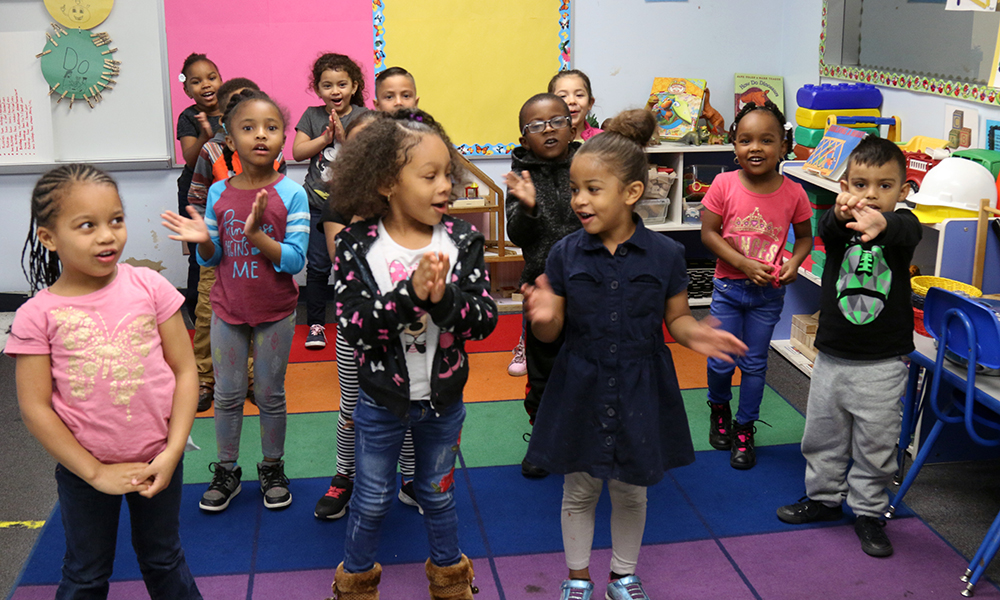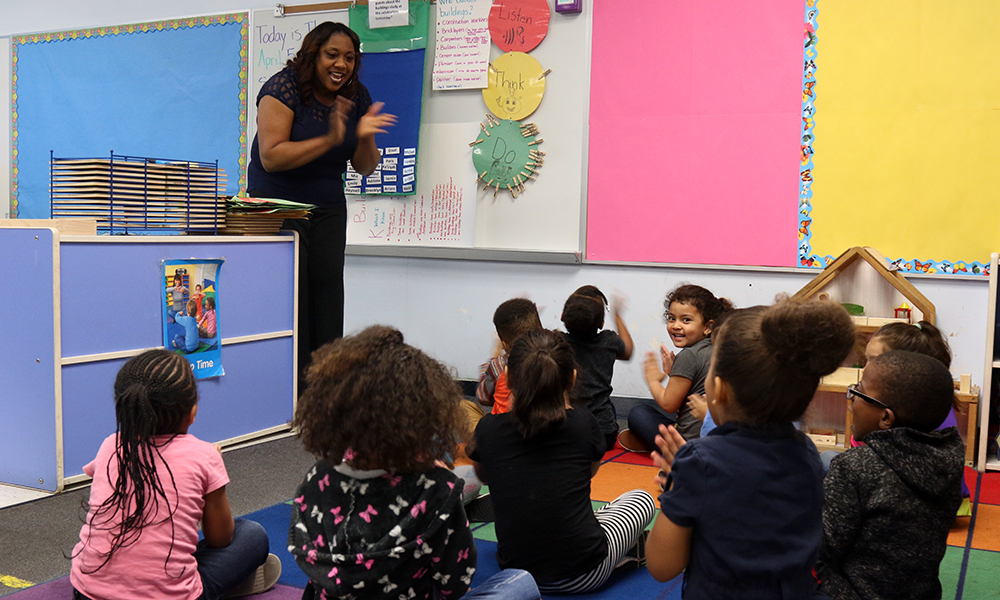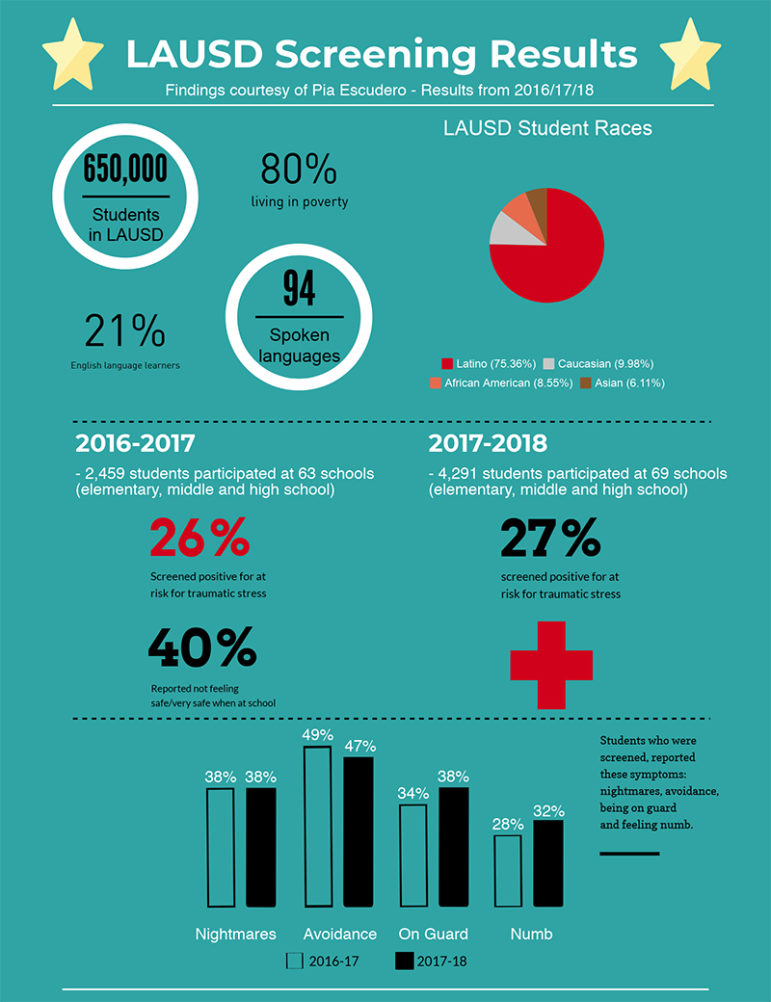
Photos by Lauren Dunn
A class at the Locke Wellness Center sings a welcome song. The center provides a wide variety of services for students and the local community.
LOS ANGELES — It is the second-largest school district in the nation with more than 640,000 students enrolled. It spans more than 720 square miles, including 900-plus schools and 187 charter schools.
And the Los Angeles Unified School District (LAUSD) is concerned about its students’ traumatic experiences. It encompasses communities where violence, poverty and teen pregnancy are commonplace.
“We have a concoction [in the neighborhoods] that really doesn’t lend itself to optimal learning,” said Pia Escudero, director of LAUSD School Mental Health (SMH). “The amount of adversities that our children experience … I want it to stop. We have way too much going on.” Between gun violence, immigration issues, the recent legalization of marijuana use and devastating fires, there has been no shortage of traumatic events affecting LA County.
 Studies in the past two decades show that a link exists between traumatic childhood experiences and academic and behavioral troubles, according to SMH.
Studies in the past two decades show that a link exists between traumatic childhood experiences and academic and behavioral troubles, according to SMH.
So the district has introduced 15 wellness centers to combat the effects of traumatic childhood experiences for both its students and the local community. The goal is to improve the students’ physical and mental health in the hope of boosting their graduation rates and academic achievement.
SMH established its first wellness centers in 2012 with the support of the Los Angeles Trust for Children’s Health (LA Trust). Since then, 14 wellness centers have been opened on or near school campuses and more than 350,000 visits have been provided. The locations of the centers were chosen based on the prevalence of indicators like “chlamydia, teen pregnancy, violence exposure, dropout graduation rates, and urban hardship,” said Maryjane Puffer, executive director of the LA Trust.
Trauma-informed approach
Locke Wellness Center is one clinic that provides a wide variety of services for students and the local community. It has a mental health clinic, early learning/development center and a general medical office where students can get immunizations, physicals, dental services, sign up for insurance plans, confidential health services such as pregnancy and STD testing and more. No student or adult is turned away.

Locke Wellness Center teacher Desilisa Mitchell leads the preschoolers in a clapping game.
Perhaps the most unique aspect of these centers is their trauma-informed approach. SMH encourages school faculty and center staff to recognize and detect trauma-induced behavior by looking through a “trauma lens” to better understand those they serve.
Research has confirmed that Adverse Childhood Experiences, known as ACEs, can lead to lower grade-point averages and graduation rates, increased school absences and incidents of overreaction. To encourage healing and detect and intervene early, LAUSD conducted its own screening and data evaluation to further prove the link between trauma and lower academic success.
Their 2016-17 screening of 2,500 students from 63 elementary, middle and high schools revealed 26 percent of the students were at risk for traumatic stress while 40 percent of students reported that they did not feel safe or very safe when at school.
Some of the most common symptoms included nightmares, avoidance, feeling on guard and numbness, according to 2016-18 data. A lack of problem-solving skills and a feeling of not being noticed were other big takeaways.
LAUSD is lining up this data with other school indicators such as attendance, proving that “the more support kids get, the less absent they are,” Escudero said. “They belong in the community and they end up graduating versus falling into despair, not showing up and eventually dropping out of school or getting pregnant.”
This work starts very early at Locke Early Education/Infant Center, which works with teen parents so that they can continue with their schooling. This wing of the Locke Wellness Center specifically serves children from about 8 weeks to 5 years old.
Principal Tracey Washington plans to launch trauma-informed art and dance programs in the coming year. These programs would jumpstart students on a path to being open about sharing their trauma and lead to avenues toward healing at a much earlier age.
Thomas (not his real name to protect his privacy), a student from John C. Fremont High School, was the stereotypical “problem kid” in the classroom. He got into fights after school, never stopped talking in class and was often kicked out of the classroom.
What his teachers and others didn’t realize was that Thomas had suffered from a series of traumatic events growing up, including the loss of two of his younger brothers. His mother encouraged him to go to therapy, which turned his entire mindset around. Conveniently located right on his campus, his therapy sessions were multiple times a week for a year and eight months.
“It just changed me,” he said. He was told, “Do something to knock your mind off the bad stuff,” he said.
This is exactly what Thomas did: He channeled his energy and feelings into his classwork and sports. He now loves helping others and being what he calls an “extra ear” to listen to others in need. Thomas is also hopeful about the future with goals of finishing school, going to college and making his parents proud.
The biggest roadblock to continued success for these centers is the lack of federal and state funding, according to Escudero and Puffer. Funding through grants is quite unstable and is not as conducive to growth and progress as allocations would be, Escudero added. Further, the sheer size of LA County, the nationwide stigma against mental health, as well as the long-standing shortage of mental health care treatment make this task even more daunting, said Suzanne Markey, clinical social worker at SMH.
In fact, three out of four children with mental health needs in California go untreated despite having health care coverage, according to a 2014 health policy brief by the UCLA Center for Health Policy Research.
The ultimate goal is to reach a 100 percent graduation rate and have a wellness center at every school in the district. To get there, Escudero said, a major culture shift is in order. The education and health system needs to become much more focused on preventative action as opposed to solely reactive treatments, she said.
































